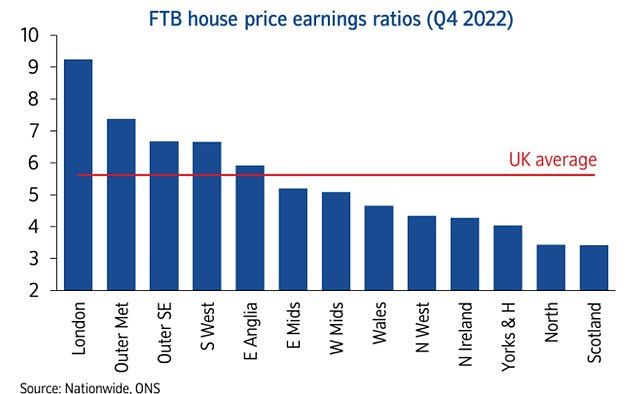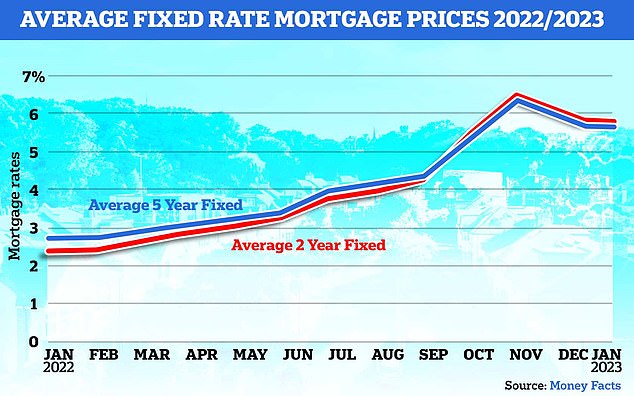First-time buyer mortgage payments now 39% of salary
>
Homes for starters are least affordable since 2008, says Nationwide, with mortgage payments eating 39% of pay
- In 2021/22, a third of starters had some help collecting a deposit
- Scotland is the most affordable area to get on the housing ladder
- Mortgage rates are falling and the fixed rate could be between 4% and 5% this year
Higher mortgage rates have eroded housing affordability in the UK, with new buyers now facing levels last seen in the run-up to the financial crisis, according to new figures from lender Nationwide.
For an average starter with a 20 percent down payment and a 5.5 percent mortgage interest, the payments will make up about 39 percent of their take-home pay.
And despite predictions of house prices falling this year, taking down a down payment is still a major hurdle for those saving for their first home.
First-time buyers are faced with a combination of high mortgage rates and unaffordable house prices
Andrew Harvey, senior economist at Nationwide, says this is due to the rapid rise in house prices in recent years and relatively slow wage growth.
“Between the start of the pandemic and the end of 2022, house prices rose by 19 percent, while incomes rose by a much more modest 9 percent,” says Harvey.
This, in turn, means that a 20 percent down payment on a typical starter home is now equivalent to 112 percent of the pre-tax income of a typical full-time worker, comparable to a year ago, and only modestly below the record 117 percent set previously. was recorded in 2022.’
And while UK households saved an extra £200bn during the lockdown, most of it was saved by older, wealthier savers, meaning new buyers are still turning to friends and family for help with a home deposit.
The data shows that in 2021/22 a third of first-time buyers had some help collecting a deposit, up from 27 per cent in the mid-1990s.

Rapid rise: Home price rises outpaced wage growth during the pandemic, leaving many struggling to save for a down payment

London has the worst house price to earnings ratio in the UK, while Scotland has the best
Moreover, the increase in rents over the past year, combined with the end of the government’s ‘Buying Aid’ scheme, puts even more pressure on first-time buyers, especially as inflation continues to outpace wage growth.
Tom Bill, head of UK residential research at Knight Frank said: ‘This is a confusing time for anyone buying a home. Mortgage interest rates are 3 percentage points higher than around this time last year, but are also falling.
‘After 13 years of extremely low borrowing costs, monthly expenses will rise by hundreds of pounds at a time when the cost of living is already corrosive.
Rates are falling, however, as the mini-budget shock works its way through the system, although any drop won’t take us much further back in time than last September. Stay close to your mortgage advisor in 2023 is the message.’
You can check how much a mortgage deal would cost you every month with our real cost mortgage calculator.

Up and down: Mortgage rates rose rapidly in the wake of the mini budget in September, but are expected to level off this year
Regionally, Scotland and the North have the lowest house price to earnings ratio of just 3.4. London, on the other hand, has the highest ratio of 9.2. At a local council level, Westminster in the capital has the worst affordability at 15.6 and Inverclyde in Scotland is the most affordable at 2.6.
In addition, some areas have become more affordable. Tewkesbury in the south west has seen affordability improve by 0.9 to 5.9, and Brent in London has improved by 0.8 to 11.1
There is also good news, as mortgage rates continue to fall from their October highs. The average two-year fixed rate is now 5.63, up from 5.79 on January 1, according to Moneyfacts.
The five-year average with a fixed interest rate also fell from 5.63 at the start of the month to 5.43. Most experts now expect rates to be somewhere between 4 and 5 percent this year, with many firm deals now below 5 percent despite a succession of base rate increases.
Samuel Mather-Holgate, financial advisor at Mather and Murray Financial said: “The data in this report comes as no surprise. The worrying thing is that the government doesn’t seem to be doing anything about it.
‘There is an urgent need for a scheme for home builders and buyers to stimulate the affordable housing market. Help to Buy was nowhere near perfect, but when it was removed it dried up an already parched part of the housing market.”
